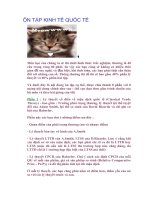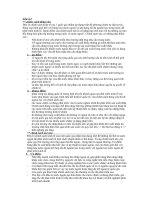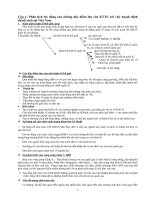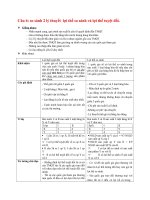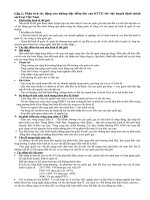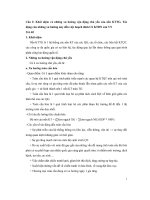ôn tập kinh tế quốc tế
Bạn đang xem bản rút gọn của tài liệu. Xem và tải ngay bản đầy đủ của tài liệu tại đây (10 MB, 44 trang )
TABLE OF CONTENT
Globalization
Definition
Benefit
Challenges
Effects of the Pandemic on Globalization / Economies
Trade
Free Trade (definition)
What is International Trade?
Pros and Cons of International Trade:
What is the trade war?
What are the negative sides of free trade?
What are the positive sides of free trade?
Free theory support free trade:
Is An Interdependent Global Economy A Good Thing? (kt phụ thuộc nhau có tốt?)
Three most important of Trade Theories:
Trade patterns for Vietnam (Mơ hình thương mại)
What are the terms of trade? (điều khoản thương mại)
What are the Consequences (Benefits and Costs) of International Trade?
Other sources of Gain from Trade
Classical Trade Theory Contributions
Why is free trade bad for developing countries?
National can loss from trade:
6
6
6
6
6
7
7
7
7
7
7
8
8
8
8
8
9
9
9
10
10
10
Mercantilism / Protectionism
11
Definition
11
The Mercantilist Views on Trade or The new contributions of Mercantilists views on Trade
11
Arguments for Protectionism: lập luận ủng hộ
12
Arguments against Protectionism (support free trade): lập luận chống lại
12
The weak point
13
The strong point of Mercantilists (benefit of neo Mercantilists countries: China, Japan..
13
Consequences of Mercantilism (Hậu quả của chủ nghĩa trọng thương)
13
Colbert’s Mercantilist Policies
14
A zero-sum game
14
Arguments for and against
14
Which Industries Are Protected?
14
The Invisible Hand (bàn tay vơ hình)
14
Absolute Advantage (lợi thế tuyệt đối)
15
Definition (include example)
15
Absolute Advantage View on Trade
15
Contribution of Adam Smith in trade theory
15
What are the gains from trade?
15
Role of Government: Government should
16
How could country that is the most (least)efficient producer of everything gain from trade?16
What is the structure/pattern of trade?
16
Why do some countries export certain products?
16
Comparative Advantage (Lợi thế tương đối)
Definition (main theme)
Sources of Comparative Advantage
Main determinant (yếu tố quyết định chính)
The Gains from Trade
Trade patterns for Vietnam
If a government restricts trade,what are the costs if foreign governments respond likewise
Implications of comparative advantage (hàm ý)
Opportunity Cost Definition (include Example)
16
16
17
17
17
17
17
17
18
National Competitive Advantage: Porter’s Diamond
Definition
18
18
Heckscher - Ohlin (H-O)
Definition (include example)
Main determinants of comparative advantages of H-O theory:
Factor endowments
Factor intensity
Heckscher-Ohlin Theorem with a Single Technique:
Determinants of comparative advantage ?
18
18
19
19
19
19
19
New trade theory
Definition
Implications of the New Trade Theory (hàm ý) - main new trade
Intra - Industry Trade:
20
20
20
20
Common trade Barriers:
Most Common Trade Barriers:
Purpose about barrier:(mục đích)
Explain how tariff could affect me, you and other company?
Welfare effects of one country reducing its tariff on a good from a partner country:
20
20
21
21
21
Reasons
Economic of Tariffs:
Consumption effect (hiệu quả tiêu dùng)
Production effect (hiệu quả sản xuất)
Trade effect
Revenue effect
Redistribution effect
Welfare Effects of a Tariff (ảnh hưởng phúc lợi của thuế quan)
The Impact of Import Tariff:
Protectionist Policies: Tariff (chính sách bảo hộ thuế quan)
Subsidies
Function of subsidies in trade policy
Effect on the subsidizing country
Subsidies: Are They Used?
Explain why the use subsidies are on the rise in recent years and give some examples?
Purpose of dumping:
The different types of dumping
Explains the dumping argument against freetrade? Lập luận ủng hộ bán phá giá
Why is dumping harmful for the economy?
Explain why subsidy and dumping are harmful for free trade?
What is anti-dumping in trade? (thuế chống bán phá giá)
What is quota?
What is the Non Tariff policy about? Definition
Nontariff barriers to imports
Non-tariff barriers to trade can arise from (phát sinh từ)
Technical Barrier TBT (rào cản kỹ thuật)
Customs Procedures
Main arguments to use subsidy and non tariff measures:
Economic integration
Economic Integration
Levels of economic integration
Economic What are PTAs?
Effects of PTAs Economic Integration:
Information for compare Economic integration
EU - VN ( example of benefit, market access ……. )
Free – Trade Area
What is the purpose of free trade agreements?
Custom Union (characteristics)
22
22
22
22
22
22
22
22
23
23
23
24
24
24
24
25
25
26
26
26
26
26
27
27
27
27
27
28
28
28
28
29
29
30
31
31
31
32
Common Market
Give some examples of common market in the world
Economic Union:
Monetary Union:
The United States - Monetary union
Monetary Union: The United States
32
32
32
33
33
33
Agreement (EU – AEC – RCEP – EVFTA - WTO)
34
Why is it beneficial for countries to engage in free trade?(tham gia thương mại có lợi?)
34
The Lure of Protectionism:(sức hấp dẫn)
34
WTO (definition + function)
34
Why do nations prefer to negotiate bilateral trade agreements than the WTO (multilateral
systems)?
34
RCEP
34
Function of RCEP? (chức năng) (benefit)
35
Which industries are expected to benefit the most in Vietnam from the RCEP?
35
FTAs (some FTAs of VN)
35
What is EV FTA?
35
EVFTA is a new generation FTA between Vietnam and 27 European Union member states.
EVFTA is one in two of the largest new generation free trade agreements that Vietnam's
largest ever negotiated.
35
Benefit of EVFTA
35
Benefit of VietNam when participating in EVFTA
36
CPTPP
36
Function of CPTPP? (chức năng)(benefit)(VN)
37
What is the ASEAN?
37
What is its main function of ASEAN?
37
The benefits for member countries of ASEAN
37
Benefit of VietNam when participating in many trade agreements
38
Less Globalization, More Multilateralism (bớt tồn cầu hóa, nhiều hơn về đa phương)
38
Trading blocs
38
Benefits of Economic Integration:
38
Impetus for Regionalism(positive impacts) động lực của CN khu vực
38
Effects of a Regional Trading Arrangement (Ảnh hưởng của thỏa thuận)
39
Static Effects of Economic Integration (ảnh hưởng tĩnh)
39
Dynamic effects of economic integration (ảnh hưởng động)
39
Lock-in reforms (cải cách khóa trong)
40
What is the EU?
40
The benefits for member countries of the EU?
40
The challenges for member countries of EU
40
Four freedoms of movement:
40
The single market has led to: (dẫn đến)
41
Cons of Unification: EU
41
Why adjustment is hard (điều chỉnh khó khăn)
41
Without adjustment (khơng cần điều chỉnh)
41
What the WTO stand for
42
WTO: Primary Functions
42
WTO’s Two Basic Principles (Today) (hai nguyên tắc cơ bản)
42
1. MFN = Most Favored Nation
42
2. National Treatment
42
What is APEC?
42
Benefit of APEC
42
The ASEAN Plus Agreements
43
What is FPI?
43
What is FDI?
43
What are the gains from trade?
43
How could a country that is the most (least) efficient producer of everything gain from trade?
43
Globalization
Definition
Globalization is a process toward a more integrated and interdependent world economy between
people, companies, and governments of different nations, a process driven by international trade
and investment and aided by information technology. This process has effects on the
environment, on culture, on political systems, on economic development and prosperity, and on
human physical well-being in societies around the world.
Benefit
- Access to New cultures
- Develop about education
- Access to New Talent, New market , New technology and innovation
- Lower costs for products and transhipment
- Lower tariff help trade to easier and more than
- Improve standards of living
- When globalization, customer have more choice because the variety of products
Challenges
- Increase wealth gap
- Easier to loss of cultural identity
- Immigrarion challenges
- Increase job loss at worker at developed country
- Polluted environment
-Challenge with domestic production must improve and develop to compete with foreign market
or MNCs
Effects of the Pandemic on Globalization / Economies
–Travel halted
–Stock markets fall
–Factories shut down
–Supply chains interrupted
–Trade plummets
–Unemployment
–Reduced GDP
–Panic buying and shortages
Trade
Free Trade (definition)
According to Smith, free trade expands the extent of the market and, thereby, allows greater
division of labor
Free trade also increases productivity by allowing countries to specialize in what they do well.
What is International Trade?
International trade is an exchange involving a good or service conducted between at least two
different countries. The exchanges can be imports or exports. As a result of international trade,
the market is more competitive. This ultimately results in more competitive pricing and brings a
cheaper product home to the consumer.
Pros and Cons of International Trade:
What is the trade war?
A trade war is an economic conflict between countries. This results in both countries imposing
trade protectionist policies against one another in the form of trade barriers. These barriers can
be imposed in a number of different ways, including but not limited to tariffs, import quotas,
domestic subsidies, currency devaluation, and embargos.
What are the negative sides of free trade?
Free trade does not create more jobs.
There are more risks for currency manipulation.
There can be fewer intellectual property protections because of free trade.
Environmental can be polluted
There can be fewer revenue generation opportunities in free trade.
It can stiffen international competition for domestic economies.
What are the positive sides of free trade?
Free trade creates economic growth opportunities.
There are more opportunities for foreign direct investment.
It lowers the taxes that consumers and businesses pay.
Fewer government expenditures occur because of free trade.
It creates better goods.
Free trade involves more than just consumer goods.
It helps the people who have the least amount of money to spend.
Free trade creates more opportunities to solicit workers with expertise.
Experts get to have access to the most resources with free trade.
Free theory support free trade:
Is An Interdependent Global Economy A Good Thing? (kt phụ thuộc nhau có tốt?)
Supporters believe that increased trade and cross-border
investment mean
– lower prices for goods and services
– greater economic growth
– higher consumer income, and more jobs
Critics worry that globalization will cause
– job losses
– environmental degradation
– the cultural imperialism of global media and MNEs
Anti-globalization protesters now regularly show up at
most major meetings of global institutions
Three most important of Trade Theories:
Trade patterns for Vietnam (Mơ hình thương mại)
Strong outward-oriented (export-dependent) economy with trade in goods and services
accounting for more than 170% of GDP.
Main exports: labour-intensive manufactures (clothing, shoes, electronics), seafood, crude oil,
rice, coffee, wooden products, machinery
Main imports: Machinery and equipment, petroleum products, steel, raw materials for
clothing/shoe industry, electronics, plastic, automotives
Services remain the strongest sector, accounting for about 43% of GDP (but only 30% of
employment)
Major services sectors: trade, finance, real estate, tourism
What are the terms of trade? (điều khoản thương mại)
Definition: the price of export goods relative to import goods – relative prices
The terms of trade of a given country are a proxy for the benefits from trade to that country
Once a country is engaged in trade, any change in world market prices affects its terms of trade,
its real income and wealth
What are the Consequences (Benefits and Costs) of International Trade?
Benefits of International Trade
Individuals
▪ Consumption of better quality products with lower prices
▪ Consumption of diverse products
Firms
▪ Greater business opportunities
▪ Greater profit
Nation
▪ Fast economic growth
▪ Job creation
Costs of International Trade
Individuals
▪ Loss of jobs employed in the less competitive industries
Firms
▪ Face stronger competition and may lose competitive edge
Nation
▪ Greater income disparity
▪ Possibility of environmental degradation in developing countries
▪Greater vulnerability to foreign shocks
Other sources of Gain from Trade
• Productivity (most productive firms expand and export)
• Returns to scale (small countries can support larger firms)
• Competition (monopolies in small countries lose market power)
• Variety (buyers can access more choices)
• Supply chains (firms source parts from cheapest sources)
• Technology (producers access foreign technologies)
Classical Trade Theory Contributions
Adam Smith—Division of Labor
– Industrial societies increase output using same labor-hours as pre-industrial society
David Ricardo—Comparative Advantage
– Countries with no obvious reason for trade can specialize in production, and trade for products
they do not produce
Gains From Trade
– A nation can achieve consumption levels beyond what it could produce by itself
Why is free trade bad for developing countries?
Trade liberalization can pose a threat to developing nations or economies because they are
forced to compete in the same market as stronger economies or nations. This challenge can stifle
established local industries or result in the failure of newly developed industries there.
National can loss from trade:
Compare Comparative - absolute advantage:
Mercantilism / Protectionism
Definition
The mercantilists maintained that the way for a nation to become rich and powerful was to
export more than it imported. Mercantilism advocates government intervention to encourage
exports and restrict imports. One nation gained only at the expense of another.
It view trade as a zero- sum game - one in which a gain by one country results in a loss by
another
The Mercantilist Views on Trade or The new contributions of Mercantilists views on Trade
– Export surpluses brought an inflow of gold and silver.
– Trade policy was to encourage exports and restrict imports.
– One nation gained only at the expense of another.
Arguments for Protectionism: lập luận ủng hộ
Arguments against Protectionism (support free trade): lập luận chống lại
The weak point
-
It creates high levels of resentment
It creates a preference for the mother nation to always be first
There is always a risk of local raw materials and resources running out
The system is ultimately quite inefficient
The strong point of Mercantilists (benefit of neo Mercantilists countries: China, Japan..
-
It encourages the complete development of all natural resources.
It encourages trade deficits for foreign nations
It naturally reduces unemployment rates
Cultural exchanges are encouraged to promote trade
Example: China's Neo-mercantilist strategies include promoting export subsidies, increase
exports, limiting imports, striving for a favorable balance of payment via exchange rate
manipulation, tariff, and other trade protections.
Consequences of Mercantilism (Hậu quả của chủ nghĩa trọng thương)
Gain to privileged merchants
Greater government control and direction of the economy Colonialism
Corruption: merchants used bribes and similar means to gain subsidies, protection for their
specific interests
Inefficient factor allocation leading to overall reduction in prosperity
Many policies self-defeating: you cannot permanently increase your exports without eventually
having greater imports
Bullionism self-defeating (price-specie flow mechanism)
Colbert’s Mercantilist Policies
Colbert’s policies
–encouraged population growth,
–Encouraged immigration of skilled workers,
–Discouraged emigration, and
–Extended corvée or forced labor throughout France in 1738
A zero-sum game
one in which a gain by one country results in a loss by another
Arguments for and against
Protectionism
1/ The infant industry argument
2/ The dying industry argument
3/ National pride
4/ National defence
5/ Income distribution
Kristoffer J. M. Hansen, Institute for Economic Policy
Which Industries Are Protected ?
Agriculture: in the U.S., Europe, and Japan farmers make up a small fraction of the electorate
but receive generous subsidies and trade protection.
– Examples: European Union’s Common Agricultural Policy, Japan’s 1000% tariff on imported
rice, America’s sugar quota.
Clothing: textiles (fabrication of cloth) and apparel (assembly of
cloth into clothing).
– Until 2005, quotas licenses granted to textile and apparel exporters were specified in the
Multi-Fiber Agreement between the U.S. and many other nations.
The Invisible Hand (bàn tay vơ hình)
That the pursuit of individual self interest leads to an excellent social outcome
Consumer sovereignty ensures that consumer needs determine what gets produced. Business
competition ensures that prices are driven down to unit cost. Thus, without any government
control, the most beneficial goods get produced, and at the lowest possible price
Absolute Advantage (lợi thế tuyệt đối)
Definition (include example)
Adam smith argued that a country has an absolute advantage in the production of a product
when it is more efficient than any other country in producing it
According to smith, countries should specialize in the production of goods for which they have
an absolute advantage and than trade these goods for the goods produced by other countries
Example: If the US uses 15 hours of labor to produce one unit of tomatoes and Mexico uses 10
hours to produce the same amount of tomatoes, Mexico has an absolute advantage in the
production of Tomatoes.
Example: Source of Advantage
– Canada is efficient in growing wheat, inefficient in growing bananas.
– Nicaragua is efficient in growing bananas, inefficient in growing wheat.
- Canada has absolute advantage in wheat, Nicaragua has absolute advantage in bananas.
– Mutually beneficial trade can take place if both
countries specialize in their absolute
advantage.
Absolute Advantage View on Trade
Specialization and trade advantage both countries.
Adam Smith and other classical economists advocated a policy of laissez-faire, or minimal
government interference with economic activity.
Free trade would cause world resources to be utilized most efficiently, maximizing world
welfare.
Contribution of Adam Smith in trade theory
What are the gains from trade?
That there are gains from trade is probably the most important insight in international
economics. Countries selling goods and services to each other almost always generate mutual
benefits.
➢Trade benefits countries by allowing them to export goods made with relatively abundant
resources and import goods made with relatively scarce resources.
➢When countries specialize, they may be more efficient due to the larger scale of production.
➢Countries may also gain by trading current resources for future resources(international
borrowing and lending) and from international migration.
Role of Government: Government should
– maintain law and order,
– ensure the defense of the nation from foreign enemies,
– erect and maintain public works that private citizens would not build
– Subsidize education for those who could not afford it, and
– Regulate international trade when free trade endangers ‘infant
industries’ or compromises national security
How could country that is the most (least)efficient producer of everything gain from trade?
Countries use finite resources to produce what they are most productive at (compared to their
other production choices), andthen trade those products for what they want to consume.
Countries can specialize in production, while consuming a great diversity of goods and services
through trade.
What is the structure/pattern of trade?
The pattern of trade describes who sells what to whom.
Differences in climate and resources explain why Brazil exports coffee and Saudi Arabia exports
oil.
Why do some countries export certain products?
Why some countries export certain products can stem from differences in:
–Labor productivity
–Relative supplies of capital, labor and land and their use in the production of different goods
and services
Comparative Advantage (Lợi thế tương đối)
Definition (main theme)
David Ricardo asked what might happen when one country has an absolute advantage in the
production of all goods.
Ricardo's theory of comparative advantage suggests that countries should specialize in the
production of those goods they produce most efficiently and buy goods that they produce less
efficiently from other countries, even if this means buying goods from other countries that they
could produce more efficiently at home
Sources of Comparative Advantage
Main determinant (yếu tố quyết định chính)
The Gains from Trade
Each country is able to consume at a point that lies beyond its ppc, reflecting the greater
productivity under international division of labour
The gains from trade for each country depends on its terms of trade: the relative price of its
exports in terms of its imports
International trade affects production, as each country specializes
And it affects consumption, as the price of imported goods decline, resulting in higher
consumption of these (substitution effect)
It also increases real incomes, so consumers tend to buy more of each product (income effect)
Trade patterns for Vietnam
Strong outward-oriented (export-dependent) economy with trade
in goods and services accounting for more than 170% of GDP.
Main exports: labour-intensive manufactures (clothing, shoes, electronics), seafood, crude oil,
rice, coffee, wooden products, machinery
Main imports: Machinery and equipment, petroleum products, steel, raw materials for
clothing/shoe industry, electronics, plastic, automotives
Services remain the strongest sector, accounting for about 43% of GDP (but only 30% of
employment)
Major services sectors: trade, finance, real estate, tourism
If a government restricts trade,what are the costs if foreign governments respond likewise
Trade policies are often chosen to cater to special interest groups, rather than to maximize
national welfare.
Governments tend to adopt tariffs, then negotiate them down in exchange for reduction in trade
barriers of other countries.
Implications of comparative advantage (hàm ý)
Policy of Laissez-faire (law of free market) still holds
Gains need not be equal
Hours of work traded need not be equal but the advantage still exists
Trade is based on the existence of relative – not absolute – production advantages
Opportunity Cost Definition (include Example)
Is the cost of a commodity is the amount of a second commodity that must be given up to
release just enough resources to produce one additional unit of the first commodity
Example: If in the absence of trade the United States must give up two-thirds of a unit of cloth
to release just enough resources to produce one additional unit of wheat domestically, then the
opportunity cost of wheat is two-thirds of a unit if cloth
National Competitive Advantage: Porter’s Diamond
Definition
– Countries have different relative abundance of factors of production.
– Production processes use factors of production with different relative intensity.
Michael Porter tried to explain why a nation achieves international success in a particular
industry and identified four attributes that promote or impede the creation of competitive
advantage:
● Factor endowments
● Demand conditions
● Relating and supporting industries
● Firm strategy, structure, and rivalry
Heckscher - Ohlin (H-O)
Definition (include example)
A nation will export the commodity whose production requires the intensive use of the nation's
relatively abundant and cheap factor and import the commodity whose production requires the
intensive use of the nation's relatively scarce and expensive factor
Model based on two concepts:
1. Factor endowments—the quantities of productive resources possessed by a country
2. Factor intensity—the amount of labor per unit of capital used in production of a product
Example: This is why labor-abundant countries, such as India and China export footwear, rugs,
textiles, and other labor intensive commodities; and land-abundant countries, such as Argentina,
Australia, and Canada, export meat, wheat, wool, and other land- intensive commodities.
Main determinants of comparative advantages of H-O theory:
Factor endowments
the quantities of productive resources possessed by a country.
Factor endowments refer to a nation's position in factors of production necessary to compete in a
given industry
A nation's position in factors of production can lead to competitive advantage vd, Singapo,....
These factors can be either basic (natural resources, climate, location) or advanced (skilled labor,
infrastructure, technological know-how)
Factor intensity
the amount of labor per unit of capital used in production of a product.
The nations differ in that one is relatively labor abundant while the other is relatively capital
abundant. Further, the commodities produced differ in factor intensity.
Factor intensity is determined by the ratio of capital (K) to labor (L) required for the production
of the commodity.
For example, the U.S. has more of both labor and capital than Mexico, but the quantity of capital
advantage in the U.S. over Mexico is greater than the quantity of labor advantage in the U.S.
over Mexico => The U.S., therefore, is capital abundant and Mexico is labor abundant.
Heckscher-Ohlin Theorem with a Single Technique:
• The structure of trade, in general, can be traced back to differences in factor endowments,
technology, and tastes.
• Since Heckscher-Ohlin theory assumes that technology and tastes are similar between
countries, it attributes the comparative
advantage to differences in factor endowments.
In summary, the capital-abundant country exports the capital-intensive commodity, and the
labor-abundant country exports the labor intensive commodity
Determinants of comparative advantage ?
o Differences in factor endowments not on differences in productivity determine patterns of
trade (comparative advantage)
o Absolute amounts of factor endowments matter.
oFactor endowments vary among countries
o Products differ according to the types of factors that they need as inputs
o A country has a comparative advantage in producing products that intensively use factors of
production (resources) it has in abundance
o Factors of production: labor, capital, land, human resources, technology
New trade theory
Definition
New trade theory suggests that the ability of firms to gain economies of scale (unit cost
reductions associated with a large scale of output) can have important implications for
international trade
New trade theory suggests that:
through its impact on economies of scale, trade can increase the variety of goods available to
consumers and decrease the average cost of those goods
in those industries when output required to attain economies of scale represents a significant
proportion of total world demand, the global market may only be able to support a small number
of enterprises
Implications of the New Trade Theory (hàm ý) - main new trade
1. Countries may export the same good to each other
2. Countries may lose from trade
3. More and broader reasons for countries to gain from trade
4. New rationales for using policy to affect trade
…
Intra - Industry Trade:
Intra-industry trade refers to the exchange of similar products belonging to the same industry.
The term is usually applied to international trade, where the same types of goods or services are
both imported and exported.
Common trade Barriers:
Most Common Trade Barriers:
1. Tariffs: A tariff is simply a tax on imports (import tariff) or exports (export tariff). Tariffs are
the most common type of trade restriction.
2. Export and Production Subsidies:
Government payments made to domestic firms encourage exports or production in general.
3. Dumping takes place when a firm or an industry sells products on the world market at price
below the cost of production.
4.Customs Procedures All countries have customs procedures for maintaining border security
and collecting tariffs
5. Local Content Requirement
A local content requirement is a regulation that requires a specified fraction of a final good to be
produced domestically.
Purpose about barrier:(mục đích)
Governments offer barriers to encourage domestic production, encourage import and export and
stabilize their economies.
It also creates favorable conditions for business organizations to participate in international labor
division, expand import, export activities and protect the domestic market
Especially due to uneven economic development, countries maintain trade barriers to protect
domestic production.
Explain how tariff could affect me, you and other company?
Tariffs hurt consumers because it increases the price of imported goods. Because an importer has
to pay a tax in the form of tariffs on the goods that they are importing, they pass this increased
cost onto consumers in the form of higher prices.
Welfare effects of one country reducing its tariff on a good from a partner country:
– Importing country
Gains from trade creation
Loses from trade diversion (we’ll see why
shortly)
– Partner country gains regardless
– Rest of world
Loses from trade diversion
Not much affected by trade creation
Reasons
– Trade creation is much like true free trade
At zero tariff, import from partner only if its cost is lower Thus resources are used more
efficiently
– Trade diversion is not like true free trade
What was imported from 3rd country, not partner, when both paid the same tariff, must
have cost more in the partner than in the 3rd country
Switching to the partner is a switch to a higher cost source for the good
Economic of Tariffs:
Tariffs are the most common type of trade restriction
A tariff requires the importer of a good to pay a specified fraction of the world price to the
government
By raising the domestic price of imports, a tariff helps domestic producers but hurts domestic
consumers
Consumption effect (hiệu quả tiêu dùng)
– Domestic consumers reduce their consumption.
Production effect (hiệu quả sản xuất)
– Higher prices make it profitable for domestic producers to increase their output.
– Thus the tariff attracts resources into the protected industry from other sectors of the economy.
Trade effect
– The tariff causes imports to fall.
Revenue effect
– After the imposition of the tariff, the government collects a certain amount of money.
Redistribution effect
– The tariff redistributes income from consumers to producers.
Welfare Effects of a Tariff (ảnh hưởng phúc lợi của thuế quan)
Consumers of the imported good are worse off (compared to free trade)
Producers of the imported good are better off
The government gains some revenue
Total surplus decreases, because the loss to consumers is larger than the gains to the producers
and to the government
The decrease in total surplus is called the deadweight loss of the tariff.
The Impact of Import Tariff:
The Small-Country Case
Introducing a tariff
→ Domestic price increases
→ Domestic quantity supplied increases
→ Domestic quantity demanded falls
→ Increase of government revenues
Distributional effect
– surplus is transferred from the consumers to the producers and the government
Consumers lose more than producers and government win: deadweight loss
Protectionist Policies: Tariff (chính sách bảo hộ thuế quan)
Subsidies
Government assistance to producers
– Export subsidy: paid only for exports
– Domestic subsidy: paid for all production (but still increases exports or reduces imports)
Function of subsidies in trade policy
Effect on the subsidizing country
– In competitive industries, country loses
– Subsidies usually are intended to benefit producers, not country
– In non-competitive industries, result may be different (recall Boeing-Airbus example)
Subsidies: Are They Used?
YES!!
US, EU, Japan all have large subsidies on many agricultural products
These reduce world prices and hurt producers of these products in developing countries
Examples of US subsidies and whom they hurt:
– Corn: Mexico
– Sugar: Caribbean countries
– Cotton: Certain African countries
Explain why the use subsidies are on the rise in recent years and give some examples?
To protect nascent industries in the country and encourage the export of advantageous industries
to increase consumer surplus and protect trade
Example: During this period, Japan pursued an export-oriented strategy. In order to encourage
exports, Japan has had preferential financing policies and preferential subsidies for exports. This
is the most period of Japanese growth averaging 10.5% continuously for 12 years, the annual
industrial growth rate from 13.5% to 15.9%. Some key industries have grown at a very rapid
pace. Japan promotes exports of ships, electronics, motorcycles, cars...
Purpose of dumping:
Dumping:
– A producer temporarily reduces the prices chargabroad to drive foreign competitors out of
busin (definition)
– Acquiring a monopoly position
+ New higher prices – to offset any losses that occur during the period of cutthroat pricing
+ Prevent the entry of potential competitors
– Home governments - concerned
Retaliate with antidumping duties
The different types of dumping
Sporadic dumping: Manufactures practice sporadic dumping to get rid of excess merchandise.
A manufacturer with unsold inventories avoids starting a price war in the home market to
preserve his competitive position. Excess supplies are destroyed. Example, Asian farmers
dumped small chickens into the sea. Another method is to have the excess supply dumped in a
foreign market where the product is normally not sold. Thus, sporadic dumping is aimed at
liquidating excess stocks that may arise occasionally.
Predatory dumping: While sporadic dumping is occasional, predatory dumping is permanent.
Predatory dumping is also known as intermittent dumping. It involves sale of goods in overseas
markets at a price lower than the home market price. This is selling at a loss to gain access to a
market and eliminate competition. After the competition is eliminated, the company becomes a
monopolist. Monopoly position is then used to increase the price. Anyway, there is a
disadvantage that former competitors may rejoin the market because of high profit margins.
Example
Hitachi was accused of following predatory dumping for its EPROM (electrically programmable
read only memory) chips.Zenith in USA accused Japanese Television manufacturers of using
predatory dumping. A charge was leveled against Japanese manufacturers for false billing and
secret rebates to set low predatory prices on T.V. sets in U.S markets. It was argued that they
tried to drive U.S firms out of business in order to gain a monopoly.
Persistent dumping (Long period dumping): It involves consistent selling at lower prices in
one market than in the rest of the market. This practice is based on the fact that markets vary in
terms of overhead costs and demand characteristics. In persistent dumping, the firm may use

